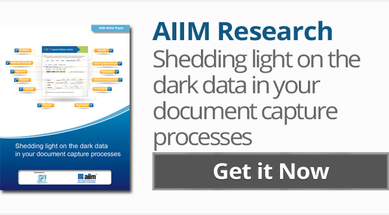First developed over 30 years ago, capture systems are a popular way to capture and digitize information that would otherwise be locked on paper. Indeed, it is common to scan a physical page and automatically extract bits of printed information so that the newly created digital version can be more easily stored and found. This “scan and store” approach reduces paper and improves access to information. But according to a new study conducted by AIIM, most organizations are failing to cash in on the full value of capture technologies. Now is the time to take a fresh look at advancements for new advantages and benefits. Here are three reasons why:
Reason #1 – Get Full Value from Capture Investments
Most organizations do not use data capture systems in ways that live up to the full potential of the technology. Earlier this year, AIIM conducted a survey of 385 companies and found that while most of the organizations participating in the study (90%) have scan and capture systems in place, only half employ any kind of text recognition technology. And although 40% indicated that their inbound forms contain handwritten data fields, very few are attempting to capture this information, either deferring it to manual keying or ignoring it outright. Indeed, over a third (37%) said that they had never even considered handwriting in the mix. This trend may be changing, however. The study shows also that a majority of companies (67%) feel that handwriting and annotations will “play a key role” and are “quite important” for their future capture strategies.
Reason #2 – Find and Utilize “Dark Content”
Organizations today are looking for ways to shed light on “Dark Content” – which, among other things, includes handwritten information that exists on forms, contracts and documents but is overlooked in the data capture process. Despite the increasing digitization of business today, a great number of business forms still contain handwritten entries – replies, notes and signatures – that are vitally important, especially when you begin to look at this data from an information governance point of view. Legal discovery, privacy, compliance, process improvement, archival and retention, and a host of other aspects and applications all point to the importance of overshadowed and overlooked handwritten content.
Reason #3 – Leverage the Growing “Intelligence” of ICR
Intelligent Character Recognition, or ICR, is an advanced character recognition technology that allows handwritten data to be digitally captured during the scanning process. This gives organizations wide ability to capture, understand and manage handwritten content that would otherwise be lost or that is generally not used in intelligent ways. In financial services it could mean checking for completeness of new account forms and for signatures on compliance statements. In healthcare it might mean finding and redacting handwritten data for HIPPA privacy compliance. For a utility or telecom company, it might mean the ability to collect and analyze handwritten log comments and include that information for use in data analytics.
Time for a Fresh Look
If you have not evaluated ICR in the past — or if you thought it was too costly or complex to implement — now is the time to take a fresh look at the technology and capabilities. Organizations can no longer afford to ignore valuable handwritten content, especially as demands for improved information governance increase. Handwritten data and free-format fields play an important role in most business processes – and an increasing one as organizations seek to exploit the “big data” they may contain. As a result, ICR and handwriting can and should be a viable and important part of your capture strategy. Look for solutions and partners that provide you with the right mix of experience, vision and advanced capabilities that will illuminate the way to discover the full value of the technology.
Guest contributor Kevin Craine is the author of the book Designing a Document Strategy, host of the Document Strategy Podcast, and a respected authority on document management and process improvement. He is the managing director of Craine Communications Group.
Download the AIIM Research: Shedding Light on the Dark Data in your Document Capture Processes.

